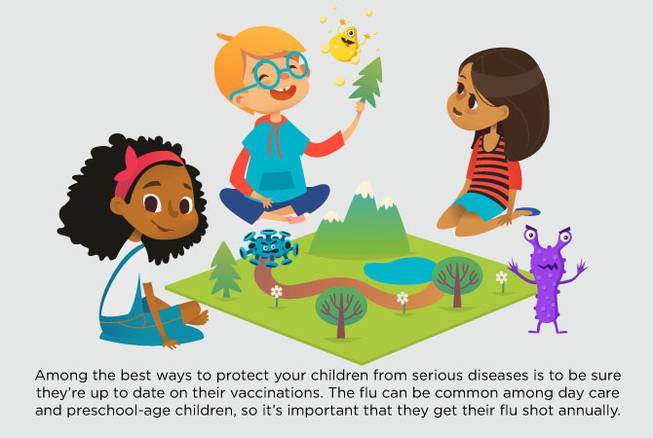
Monday, Nov. 20, 2017 | 2 a.m.
Meet the medical professionals in this story
Ellen Fitzpatrick, MD, is a MEDNAX-affiliated pediatric hospitalist at Sunrise Children's Hospital
If it seems like your young children are getting sick all the time, it’s because they probably are.
Infants and toddlers are especially prone to contracting diseases because their immune systems are in the early stages of development. Little ones in day care and preschool have an even higher risk.
“Day care centers cluster infants and young children, who are all especially susceptible to disease because their immune systems are inexperienced,” Dr. Ellen Fitzpatrick said. “They basically contract every virus they encounter. This, coupled with close quarters, sharing toys and any lapse in hand hygiene or diaper duty, creates the perfect environment for viruses and other microorganisms to breed.”
Though dealing with a sick toddler isn’t anyone’s idea of fun, these early experiences are an important piece of a child’s physical development. “Day care diseases,” as they’re often referred to colloquially, usually aren’t preventable, but knowing what to expect and how to deal with these common ailments can help.
What are ‘daycare diseases’?
“Day care disease” isn’t a medical term, but it refers to the many possible diseases that children pick up during their first years of socialization. These diseases are common in environments like day care, preschool and pre-kindergarten.
“Young children and infants who attend day care or preschool generally have a new infection every 3-4 weeks, and manifest symptoms every two months,” Fitzpatrick said.
Common daycare diseases
• Colds: While colds and upper respiratory infections are common for everyone, Fitzpatrick says parents should expect their children in day care to catch a cold 5-6 times a year. She suggests using conservative care measures such as Tylenol, Motrin, fluids, humidifiers and saline nasal spray. “I do not recommend cough medicines because there is no evidence that they work, the dosing can be confusing and they can have harmful side effects,” she said.
• RSV: Respiratory syncytial virus tends to occur in children under age 2. RSV symptoms usually are mild and similar to cold symptoms, but in some cases, RSV can cause serious diseases such as bronchiolitis and pneumonia. “Sick infants with labored breathing, color change or difficulty feeding need to get medical attention immediately,” Fitzpatrick said.
• Gastroenteritis: Also known as the stomach flu, this disease can cause vomiting, diarrhea, abdominal pain and fever. “The symptoms usually clear up within a few days with rest and fluids. Slow feeding with Pedialyte can help, but avoid fruit juices because the sugar content can make diarrhea worse,” Fitzpatrick said.
• Hand, foot and mouth disease: Caused by the Coxsackie virus, this disease is common, especially in the summer and fall, and often affects children under age 5. Symptoms include sores in the mouth and throat, and a rash on the hands, feet or legs. Fitzpatrick recommends using Tylenol or Motrin to help with the pain, as well as popsicles to soothe a sore throat. While this disease isn’t serious, it can last for 7-10 days and is very contagious. Call your pediatrician if you notice signs of dehydration, such as dry lips and trouble urinating.
• Pink eye: Conjunctivitis, or pink eye, is usually bacterial and requires antibiotic eye drops, though it also can be caused by a virus or allergies. The antibiotic drops can clear it up quickly, but the child will be contagious for 24 hours after treatment. During that time, be sure your child is washing his or her hands regularly and doesn’t touch his or her eyes. Wash linens and clothes to prevent the disease from spreading within your household.
Teach your kids how germs are spread
Glitter can be a great tool to illustrate how germs are spread. “Have kids apply hand gel and then stick their hands in glitter. Let them wipe their hands on their pants, shake hands with friends and handle their toys so they can see how glitter — and germs — spread,” Fitzpatrick said.
Prevention tips
Kids are going to get sick sometimes, but there are helpful ways to minimize the spread of germs.
• Basic hygiene and handwashing are key. Teach your kids good handwashing techniques, such as using warm water and plenty of antibacterial soap, as well as when they need to wash their hands, such as after using the restroom and before eating.
• Keep your kids at home when they’re sick. Because diseases can spread so rapidly in a day care setting, it’s important to keep them home whenever they’re sick and until you know they’re no longer contagious.
• Look for smaller day cares and preschools to minimize the number of people who could get your children sick. Fitzpatrick also recommends interviewing day cares about their hygiene practices and infection control policies.

Join the Discussion:
Check this out for a full explanation of our conversion to the LiveFyre commenting system and instructions on how to sign up for an account.
Full comments policy